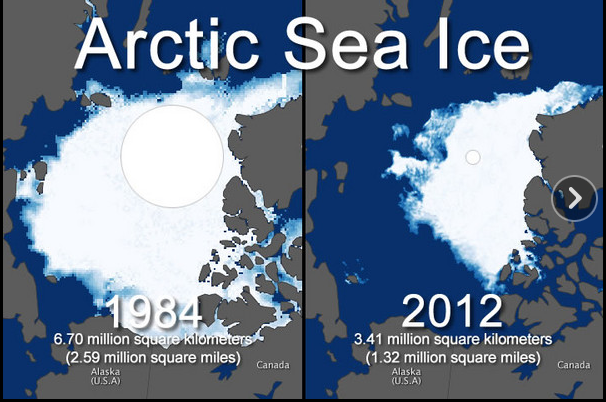
(Illustration found here).
Clear and cold this early Wednesday morning on California’s north coast and although we experienced hail, snow flurries and rain yesterday morning, the sun came out later on and life was nice.
Supposedly in the midst of a big winter storm right now, here along the Pacific rim weather can be strange to say the least — we can get a day in January just like a day in July. In fact, the last couple of weeks, prior to this particular storm front, we had some near-about summer days and some surprisingly warm temperatures.
Cold weather in February is not a shocker — don’t cry if frost appears this morning. Seasons are part of life on this planet, warm in the summer and cold in the winter — until just recently never the twain shall meet.
Not so on a warming planet.
Weather is loony nowadays and the shit starts in the Arctic.
And with the big melt last year (and continues to this day), researchers have observed a “…new phenomenon…” — shifting life under the ice for us all.
Dr. Jeff Masters explained yesterday at his WunderBlog:
In a University of Washington news release, co-author Axel Schweiger said, “people had argued that 75 to 80 percent ice volume loss was too aggressive.
What this new paper shows is that our ice loss estimates may have been too conservative, and that the recent decline is possibly more rapid.”
The U.K.’s Natural Environmental Research Council reported that the team of scientists found that from 2003 to 2012, the volume of Arctic sea ice declined 36 percent in the autumn and 9 percent in the winter.
The measure of sea ice volume is a good indicator of how the Arctic’s most stable, “multi-year” ice is fairing.
As the multi-year ice declines, sea ice extent, the total area covered by sea ice, in an “Arctic death spiral.”
The new study shows that thick, multi-year ice has disappeared in areas north of Greenland, around the Canadian Archipelago, and to the northeast of Svalbard, Norway.
…
If you remove an area of sea ice 43 percent the size of the contiguous U.S. from the ocean, like occurred in September 2012, it is guaranteed to have a significant impact on weather and climate.
The extra heat and moisture added to the atmosphere as a result of all that open water over the pole may already be altering jet stream patterns in fall and winter, bringing an increase in extreme weather events.
The record sea ice loss in 2012 also contributed to an unprecedented melting event in Greenland.
Continued sea ice loss will further increase melting from Greenland, contributing to sea level rise and storm surge damages.
Sea ice loss will also continue to crank up the thermostat over Arctic permafrost regions.
This will potentially release a significant fraction of the vast amounts of carbon currently locked in the permafrost, further accelerating global warming.
And from Climate Central a look at what this thinning ice is actually doing to the region — accelerating the growth of algae, which again only speeds global warming:
Though researchers all the way back to 19th-century Norwegian explorer Fridtjof Nansen had noted colonies of Melosira hanging under the ice, they had always assumed the algae prospered in areas covered by thick “multi-year†ice that had survived several summer melt seasons.
That wasn’t the case last summer.
The Polarstern crew found large clumps of the algae growing in areas covered by ice that was just 3 feet thick, not 10.
Stranger still, when the researchers sent high-powered cameras to the ocean floor — using a small, unmanned robot and other equipment — they found it blanketed with lush green clumps of algae.
“I was shocked when I sat there on board the ship and these images came up,†said the new study’s lead author, Antje Boetius, a biological oceanographer at the Alfred Wegener Institute for Polar and Marine Research in Germany.
“I was really screaming. Even the captain came down to look at what was going on.
The sailors said, ‘How is it possible that the sea floor is green?’â€
Green isn’t really the color — more like brown/or/white out.
In Minnesota, the snow is the snow, but less:
“It is a paradox.
Our winters are shrinking. We are not really getting as much bitter air, the nasty sub zero stuff, but when it does snow, because it’s warmer, warm air can hold more water vapor, kind of like a sponge soaking up moisture.
We can get more intense snowfalls,” said Paul Douglas, founder and meteorologist at Weather Nation, a national weather cable channel based in Excelsior.
He says Minnesota’s atmosphere has warmed two to three degrees, bringing turbo charged storms out of the higher amounts of moisture in the warm air, and not just in winter, but summer too.
“We have had three 1,000-year rains in Southern Minnesota since 2000 … Duluth last June, 10 inches of rain in the North Woods, no one can recall seeing it rain that hard,” said Douglas.
Warm is cold’s new normal.